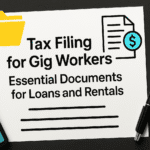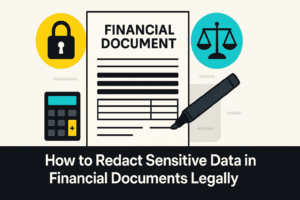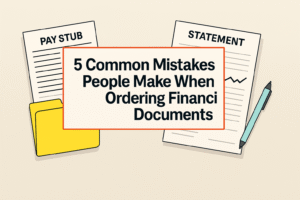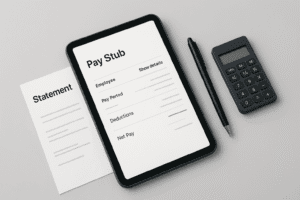Last updated: August 2025
When you apply for a mortgage, auto loan or small‑business line of credit, underwriters examine every page. Even minor inconsistencies can push your file into secondary review or result in a fast rejection. Across the United States, United Kingdom and Canada, reviewers look for patterns—commonly called loan application red flags—that signal risk.
The good news: most red flags are preventable. By packaging your pay stubs, bank statements, tax forms and ID in a clean, consistent format, you help reviewers verify details quickly and reduce back‑and‑forth.
At FinancialDocsProvider.com, we present genuine financial records in their best light. We organise, redact and format documents—never altering facts. This article explains seven document red flags that often derail applications and shows practical fixes so you can submit with confidence.
Related Entities & Terms
- Proof of income: W‑2 wages, 1099 income, T4 slips, Notice of Assessment (NOA)
- Pay stubs/payslips, earnings statements and bank statements
- Self‑employment records: invoices, ledgers, profit & loss statements
- Consumer regulators: Consumer Financial Protection Bureau (CFPB), Federal Trade Commission (FTC), Internal Revenue Service (IRS); Financial Conduct Authority (FCA), GOV.UK guidance; Financial Consumer Agency of Canada (FCAC), Canada Revenue Agency (CRA)
- Compliance concepts: Anti‑Money Laundering (AML), Know Your Customer (KYC), Source of Funds (SOF), Source of Wealth (SOW)
- Document metadata, PDF redaction, OCR and file compression
- Identity documents: passports, driver licences, national insurance numbers (NINO/SIN)
- Loan types: mortgages, auto loans, personal lines of credit, SBA and SMB financing
If you’re unsure about any step, our team offers proof of income editing and bank statement formatting services focused on clarity and compliance. We reference relevant local laws and practices for the US, UK and Canada—and we never fabricate data.
What are the legal basics of avoiding document fraud for loan applications?
Underwriters assess your finances and the integrity of your documents. Most jurisdictions clearly distinguish lawful presentation—formatting and privacy redaction—from illegal falsification. Knowing this boundary keeps you compliant and speeds approvals.
United States: You may redact personal information or improve readability as long as facts remain intact. The IRS notes that you must keep receipts and records that support income or deductions “as long as they may become material in the administration of any provision of the Internal Revenue Code”:contentReference. Altering figures or dates can constitute fraud. If you spot an error, dispute it with your bank or issuer rather than editing it yourself. Consumers can also submit complaints to the CFPB and other agencies when they suspect scams or inaccuracies.
United Kingdom: UK law takes a strict approach to dishonesty. Section 2 of the Fraud Act 2006 states that a person commits fraud if they “dishonestly make a false representation” with intent to make a gain or cause loss. Fabricating or misrepresenting financial details to secure credit is illegal. Formatting for privacy—such as masking National Insurance numbers or consolidating multiple payslips into one PDF—is permissible when the underlying data remains unchanged.
Canada: The Financial Consumer Agency of Canada oversees the conduct of federally regulated banks and requires an “effective and timely complaint‑handling process”:contentReference. If you detect a statement error, raise it with your bank and, if unresolved, the Ombudsman for Banking Services and Investments. Changing numbers or dates on your own is never acceptable; submit only bank‑issued corrections.
The unifying principle: you may organise, compress, bookmark and redact your files so they’re easy to follow, but you must not alter the substance. If you’re unsure about an edit, ask the requester or check the relevant regulator listed below.

Which edits are allowed?
Permissible edits improve clarity without changing facts. Reviewers appreciate documents that are easy to read and verify, and most regulators permit limited redaction of sensitive details. The goal is readability, not revision.
Redaction for privacy
Redaction is common when submitting statements to landlords or lenders. It’s acceptable to mask personally identifiable information (PII) such as Social Security/National Insurance numbers, account numbers (except the last few digits) and home addresses. Use proper PDF redaction tools that permanently remove the text layer, not boxes drawn over text.
Keep visible the information underwriters need: your name, issuing institution, statement period, running balances and line‑item transactions. In the UK and Canada, masking part of your SIN/NINO is standard practice and does not undermine evidentiary value when the rest of the document is intact. If an employer or bank requires full digits, submit that version securely.
Practical example: For a three‑month bank statement, you can redact the middle digits of your account number and the street number of your address, while leaving all balances and transactions unobscured. You should not remove overdrafts, chargebacks or fees—even if they feel unflattering.
Readability and packaging improvements
Poor scans and messy exports are often misread as red flags. You may rotate pages, straighten skewed scans, remove blank pages, run OCR on paper statements and combine files into a single, bookmarked PDF. Descriptive file names (e.g., Lastname_Firstname_Bank_Jan–Mar_2025.pdf) and a concise cover page summarising what’s included help reviewers work faster.
Compress oversized images to standard PDF sizes and ensure page numbering is continuous and accurate. If a figure is incorrect—for example, a missing transaction—do not “fix” it in the PDF. Instead, file a dispute with your bank and attach the bank’s corrected statement. Regulation E in the US and similar rules in Canada require banks to resolve certain errors:contentReference. Clear packaging plus official corrections is the compliant path.
What edits are illegal and why?
Altering a document’s facts is misrepresentation and may be treated as fraud. It is never acceptable to change balances, dates, names or other substantive details. Such edits trigger immediate rejection and can lead to institutional blacklisting or legal consequences.
Changes to amounts, dates or parties
Do not inflate income, delete negative transactions, shift deposit dates into a requested period or rename payment descriptions to resemble wages. The Fraud Act 2006 criminalises “false representation” intended to make a gain or cause loss. In the US and Canada, forging documents can violate bank‑fraud and credit‑fraud statutes.
Illustration: Moving a 31 March deposit into April to meet a lender’s date range is a false representation. So is renaming peer‑to‑peer transfers as “Payroll”. Both will be exposed when underwriters recompute running balances or request employer verifications.
Forgery and metadata manipulation
Adding or removing pages, altering logos or watermarks, or using PDF metadata tools to hide editing software are classic red flags. Many underwriters check the PDF “Creator” field; if it lists consumer editing software or a known fake‑document generator, they may reject the file on the spot. Duplicating transactions or deleting overdrafts will also fail when reviewers reconcile totals.
Digital forensics tip: Audit trails, inconsistent fonts, mismatched kerning and lossy image artefacts often reveal manipulation. Official downloads from your bank or payroll portal are the safest source files.
Consequences of falsification
Illegal edits risk far more than a declined loan. Potential outcomes include:
- Denial and blacklisting: Lenders share notes about fraudulent documents and may refuse future applications.
- Account closures: Banks can close accounts when they detect tampering.
- Legal exposure: Fraud by false representation (UK), identity theft, and wire‑fraud statutes can apply. In Canada and the US, regulators have prosecuted sellers of fake documents.
- Collateral damage: Landlords, loan officers and other creditors may notify one another about high‑risk applicants.
- Allowed: Redacting PII, combining files, fixing orientation, OCR, bookmarking, compressing, summarising visible totals.
- Illegal: Changing balances, dates, names or employers; adding or removing transactions; altering logos or watermarks; forging documents or metadata.
When in doubt, leave the figures alone. Ask the requesting institution for guidance and dispute errors only through official channels.
When do you need professional document formatting?
Not everyone has the time or tools to package complex financial records. Professional formatting helps your application clear initial screening with fewer questions. These common scenarios show where our support adds measurable value.
Renters and auto loans
Landlords and auto lenders typically ask for 2–6 months of statements to verify income and spending. Missing pages, mismatched names or poor scans cause delays and follow‑up requests. Our team merges statements, bookmarks each month and runs OCR so underwriters can search and verify quickly.
Mini‑scenario: A renter paid part‑time wages weekly and also received student‑loan disbursements. We packaged three months of bank statements with bookmarks by month, added a cover page listing the visible total deposits per month and left all overdraft fees intact. The landlord could trace each payroll deposit to the employer name shown on the statements.
For variable pay cycles, we attach a summary sheet of totals already present on the statements (no new numbers). Read more about common statement anomalies in our bank statement red flags checklist.
Small‑business and self‑employed financing
Small‑business lenders usually require a packet of personal and business statements, tax returns and proof of income. We line up periods across W‑2s, 1099s, T4s or NOAs, cross‑check visible totals and label each form clearly so reviewers can follow the trail.
Mini‑scenario: A freelancer had monthly retainers and ad‑hoc invoices paid by transfer. We grouped invoices by client, matched each to the bank deposit description and included a note showing the invoice number alongside the visible deposit. The packet made Source‑of‑Funds checks straightforward.
For more guidance, see our comparison of pay stubs vs bank statements.
Mortgages, grants and complex loans
Mortgage underwriters cross‑check pay stubs or self‑employment records against deposits, tax returns and employer letters. We prepare a structured package with indexed forms and a summary sheet highlighting key totals already present, then attach supporting NOAs or SA302s where relevant.
Mini‑scenario: A first‑time buyer had a bonus that fell just outside the lender’s three‑month window. We included the full six‑month statement set with clear bookmarks and a short note directing attention to the visible YTD figure on the payslip. The underwriter could see the bonus accounted for in the YTD math without any edits to numbers.
Our guide to detecting fake pay stubs explains why precision and consistency matter.
How does FinancialDocsProvider.com work?
We follow a structured, compliance‑first workflow. Our job is to make your genuine records easy to review—never to fabricate or embellish them. Here’s what to expect when you engage us.
1 – Intake
You securely upload your documents and tell us what the requester needs—months, document types and deadlines. We confirm that the work is limited to formatting and redaction, never fabrication, and outline scope and timing. For service tiers and costs, see our service options and pricing.
2 – Reconciliation & formatting
We align statement periods, confirm page counts and check sequences. We cross‑check running balances so they flow month to month. Then we redact sensitive information, rotate or crop pages, remove blanks, run OCR and add bookmarks or a table of contents. Our summary sheet highlights key totals already present in the documents—no new calculations.
The IRS emphasises that taxpayers must keep records supporting income or deductions for at least three years:contentReference. We encourage you to preserve originals in a secure location.
3 – Delivery
We deliver a single, organised PDF package with descriptive file names and a note about the scope of work—formatting and redaction only—so reviewers know the underlying data remains unchanged. You receive your originals back and we recommend retaining them for your records. If you have questions or a complex situation, contact our team or learn more about our process.
What’s on the compliance checklist?
Before sending your loan package, run through this checklist to catch common oversights. Ten careful minutes now can prevent days of back‑and‑forth later.
- Confirm the requirements: Ask the lender or landlord how many months or pay periods they need and which document types (bank statements, pay stubs, tax forms, NOAs, etc.). Provide exactly that—no more, no less. If they ask for “most recent three months,” include the current partial month only if requested.
- Match names and addresses: Ensure your legal name and current address match across ID, statements and tax forms. If you recently changed your name or address, include a brief explanation or official change notice to avoid confusion.
- Check dates and balances: Reconcile running balances across consecutive statements and verify that YTD totals on pay stubs align with the sum of prior periods. If a deposit appears twice due to a reversal, leave both entries visible.
- Check page sequence & scan quality: Confirm that all pages are present, numbered correctly and legible. Avoid missing or duplicate pages, blurry text and mismatched fonts; run OCR when possible. Never crop footers or page numbers.
- Redact responsibly: Mask only what’s necessary—the middle digits of account or Social Security numbers, or the street number of your address—and leave all financial figures untouched. Keep the issuer’s name and statement period visible.
- Package logically: Combine documents into a single PDF or organised packet with bookmarks. Use descriptive file names and add a table of contents or cover sheet explaining what’s included and the time span covered.
- Retain originals: Keep bank‑issued or payroll originals in a safe place. The IRS requires record retention for at least three years:contentReference, and similar principles apply in the UK and Canada. Originals resolve questions fast.
- Ask for help: If a requirement is unclear or you need assistance packaging your file, reach out to us. Professional formatting and compliance checks can prevent avoidable rejections.
What loan application red flags trigger rejections?
Underwriters are trained to spot anomalies that suggest missing data, inconsistency or tampering. Here are seven common document red flags that lead to rejections or secondary review—and practical ways to address them.
1. Mismatched names or addresses
If the name or address on your statements doesn’t match your ID, lenders may suspect identity issues. Avoid nicknames. Update old addresses and provide supporting documents (e.g., a marriage certificate or change‑of‑address notice) if you’ve recently changed details. A short letter of explanation pre‑empts questions.
- How to fix: Use the exact legal name that appears on your ID. Include proof of a name change if applicable.
- Helpful add‑on: If your statements still show a previous address, attach a utility bill or lease for your current address.
2. Missing pages or page sequence gaps
Bank statements list page numbers. Missing or duplicate pages look like you’re hiding something. Combine all pages into one file, ensure numbering is continuous and include any intentionally blank pages. When scanning, don’t crop footers or page numbers.
- How to fix: Re‑download statements directly from your bank or rescan the full set. Verify page counts on the cover page.
- Helpful add‑on: Add bookmarks per month and include a cover sheet noting the total pages per statement.
Our article on common legal mistakes explains why missing pages raise suspicion.
3. Running balance inconsistencies
Lenders recompute running balances. If deposits minus withdrawals don’t equal the change in balance, your file is flagged. Cross‑check your statements and leave overdrafts and fees intact. If a transaction belongs to another account, note it rather than deleting it.
- How to fix: Reconcile each month’s opening and closing balance. Match any reversals with the corresponding correcting entry.
- Helpful add‑on: If a bank error exists, submit the original plus the bank’s official correction or dispute reference.
4. Repetitive round‑number deposits
Repeated round numbers—e.g., exactly $2,000 every Friday—can look manufactured. Explain fixed retainer payments with a contract or invoice schedule. Self‑employed applicants should include a profit‑and‑loss statement or invoice summary that ties to bank deposits.
- How to fix: Provide invoices, pay schedules or an employment contract that explains the cadence and amount.
- Helpful add‑on: Include a one‑page table linking each visible deposit to its invoice or pay period.
5. Font, spacing and metadata anomalies
Inconsistent fonts, misaligned columns, low‑resolution logos or outdated branding can signal tampering. Underwriters inspect PDF metadata; if the “Creator” field lists consumer editing tools, they may request originals or decline the file. Use official downloads and avoid generator sites.
- How to fix: Re‑export the statement from your bank or payroll portal. Do not edit logos, headers or footers.
- Helpful add‑on: If you only have paper copies, scan clearly at 300 dpi and run OCR without altering content.
Our guide on detecting fake pay stubs details how metadata flags expose falsification.
6. Duplicate or missing transactions
Deleting transactions or duplicating credits to inflate income undermines your application. Include all transactions and explain unusual items. If you bounced a cheque due to timing, note that you corrected it. For actual errors, dispute them with your bank and attach the corrected statement.
- How to fix: Leave the full transaction history visible, including reversals and fees. Provide context in a short note.
- Helpful add‑on: Where applicable, include the bank’s acknowledgment of an error investigation.
7. Large or unexplained cash activity
Frequent large deposits or withdrawals without clear sources raise questions about the origin of funds. Provide receipts, invoice numbers or a schedule linking each deposit to its source. For asset sales, include a bill of sale with buyer and item details.
- How to fix: Tie each cash deposit to a documented source such as an invoice, gift letter or sale paperwork.
- Helpful add‑on: Add a brief Source‑of‑Funds note that outlines amounts, dates and counterparties.
Our financial document services can package your file and flag potential issues before you submit.
Where can I find official resources & more help?
For deeper dives into regulations and best practices, start with these authoritative sources. We also link to internal guides that show what underwriters look for and how to avoid common pitfalls.
Official resources
- Consumer Financial Protection Bureau (CFPB) – guidance on consumer finance, complaint submission and fraud prevention.
- Federal Trade Commission (FTC) – information on identity theft, scams and unfair practices.
- IRS Recordkeeping Topic 305 – outlines how long to keep financial records and why:contentReference.
- Fraud Act 2006 (UK) – defines fraud by false representation and its penalties.
- Financial Conduct Authority Handbook – rules on banking conduct and disclosure.
- FCAC: Complaint‑handling process – explains how Canada’s consumer regulator ensures banks respond to complaints:contentReference.
- Canada Revenue Agency (CRA) – for retrieving your Notice of Assessment and understanding your tax obligations.
Internal resources
- Bank statement red flags checklist – a deeper look at anomalies that delay approvals.
- Common legal mistakes in bank statement editing – explains how to avoid missteps when tidying statements.
- Detecting fake pay stubs – reveals how reviewers spot fraudulent income documents.
- Pay stub vs bank statement – compares which proof works best for different lenders and situations.
If you’re ready to move forward, explore our services, check pricing or contact our team. We’re here to help you meet compliance requirements and get approved faster.
FAQs
Do underwriters actually read every page of my documents?
Yes. While automated systems flag anomalies, human underwriters or loan processors review complete statements, pay stubs and tax forms to verify income and identify risks. Missing pages, inconsistent names or altered data slow them down and can prompt requests for originals.
Can I submit photos of my documents instead of PDFs?
Generally no. Most lenders require clear, contiguous PDFs because photos can distort scale and metadata, making authenticity checks harder. If you only have paper copies, scan them with a flat‑bed scanner or a reputable scanning app with OCR. We can combine and format them for you.
How long should I keep my original bank statements and pay stubs?
The IRS recommends retaining records supporting income or deductions for at least the period of limitations—generally three years:contentReference. For property or business transactions, keep them longer. Similar principles apply in the UK and Canada. Keeping originals helps resolve disputes quickly.
What should I do if I find an error on my statement?
Do not edit the PDF yourself. File a dispute with your bank immediately. In Canada, banks must provide an effective and timely complaint‑handling process:contentReference. In the US, Regulation E outlines error resolution procedures. Once the bank issues a corrected statement, use that version. If timing is tight, include the original and your dispute letter so underwriters see you acted properly.
Is it ever acceptable to use online pay stub or bank statement generators?
Templates can illustrate format, but they are not proof of income. If a generator output reflects your actual payroll, your employer’s official records should match it. If it doesn’t match bank deposits, YTD math or employer confirmations, underwriters may reject your application. Always submit documents produced by your employer, bank or tax agency.
Need accurate, reliable financial documents fast? Contact FinancialDocsProvider.com now.
Author: The FinancialDocsProvider Editorial Team. We are compliance specialists who focus on document formatting, verification and packaging for renters, home‑buyers and self‑employed professionals. Learn more about us.






Add comment